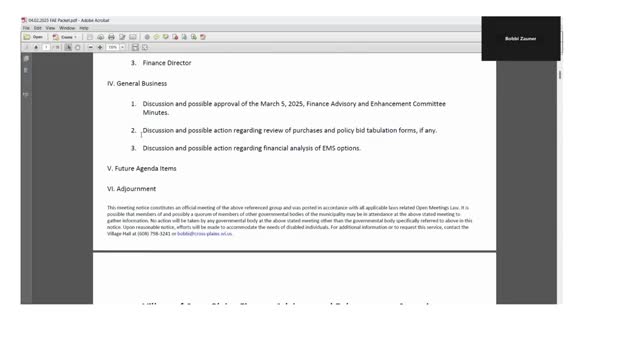Committee sets May meeting to focus on EMS financial analysis and valuation options
April 06, 2025 | Village of Cross Plains, Dane County, Wisconsin
This article was created by AI summarizing key points discussed. AI makes mistakes, so for full details and context, please refer to the video of the full meeting. Please report any errors so we can fix them. Report an error »

The Village of Cross Plains Finance Advisory & Enhancement Committee set its next full meeting for May 7, 2025, and directed members to prepare written components for a focused financial analysis of EMS options, including valuations of buildings and equipment, operating costs and revenue models under different governance scenarios.
Committee members were assigned tasks: prepare historical capital and operating cost breakdowns, estimate day‑to‑day operating costs, and draft revenue scenarios for standalone village EMS versus joint or merged regional arrangements. The committee discussed valuation approaches for EMS district assets: using historical costs (what jurisdictions originally paid), replacement-cost appraisal, or a market-based appraisal. Several members recommended obtaining an appraisal agreeable to all jurisdictions if a shared valuation is needed; others suggested presenting multiple valuation methods in the report.
Members discussed the revenue-allocation methods used in existing EMS/fire districts: some jurisdictions allocate costs using assessed or equalized property value; others base allocations more directly on population or households. Committee members noted that assessed value and equalized value differ across jurisdictions and that state equalized value provides a consistent basis used by many fire districts; however, several members argued EMS is a people-centered service and questioned whether population-based allocation might be more equitable.
The group reviewed potential grant sources: feasibility-study grants for merger planning and other state grants. Staff noted certain state grant funds must be kept in separate accounts and only used for specified purchases; the committee also referenced an approximately $34,000 pass-through grant account for EMS in the bills packet (staff said that grant funds are tracked separately and spent per grant terms).
Assignments were confirmed: members will develop written inputs (background, revenue and expense scenarios, staffing/impact on village staff) for the May meeting so staff can assemble a written report and a set of options for the committee to review. No final policy decision was made; the May meeting will serve as the committee’s primary review and consolidation meeting.
Committee members were assigned tasks: prepare historical capital and operating cost breakdowns, estimate day‑to‑day operating costs, and draft revenue scenarios for standalone village EMS versus joint or merged regional arrangements. The committee discussed valuation approaches for EMS district assets: using historical costs (what jurisdictions originally paid), replacement-cost appraisal, or a market-based appraisal. Several members recommended obtaining an appraisal agreeable to all jurisdictions if a shared valuation is needed; others suggested presenting multiple valuation methods in the report.
Members discussed the revenue-allocation methods used in existing EMS/fire districts: some jurisdictions allocate costs using assessed or equalized property value; others base allocations more directly on population or households. Committee members noted that assessed value and equalized value differ across jurisdictions and that state equalized value provides a consistent basis used by many fire districts; however, several members argued EMS is a people-centered service and questioned whether population-based allocation might be more equitable.
The group reviewed potential grant sources: feasibility-study grants for merger planning and other state grants. Staff noted certain state grant funds must be kept in separate accounts and only used for specified purchases; the committee also referenced an approximately $34,000 pass-through grant account for EMS in the bills packet (staff said that grant funds are tracked separately and spent per grant terms).
Assignments were confirmed: members will develop written inputs (background, revenue and expense scenarios, staffing/impact on village staff) for the May meeting so staff can assemble a written report and a set of options for the committee to review. No final policy decision was made; the May meeting will serve as the committee’s primary review and consolidation meeting.
View full meeting
This article is based on a recent meeting—watch the full video and explore the complete transcript for deeper insights into the discussion.
View full meeting
